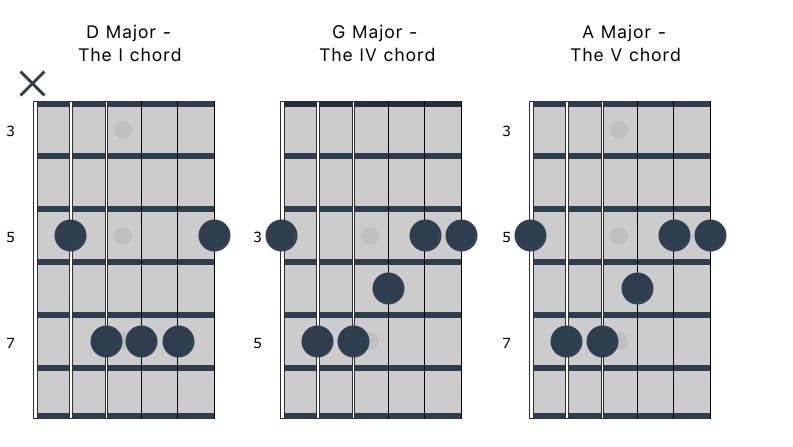Movable Chord Shapes
Guitar Noises #26: February 16, 2022

Music is patterns. Those patterns move us and sometimes even surprise us. We enjoy music in part because of the patterns, whether they are familiar to us or not.
For music learners those “a-ha” moments happen when we start to recognize a pattern. Working out how music works can sometimes feel like math class. You struggle with a series of problems until suddenly you see something that was there all along. You’ve discerned a pattern and can exclaim: “Now I know what to do!”
I still remember the excitement of someone showing me barre chords for the first time. It was actually the person showing me the chords who was really excited. “You can play anything! Anywhere!” He could barely contain his excitement. Although he showed me how to play barre chords he left out the part on how to put them all together.
Nearly everyone starts out with open position guitar chords. They are easier to play and they sound nice. But without a capo they can’t be moved around the neck very easily. To get a well rounded sound on guitar you have to move beyond just playing basic open chords.
Barre chords aren’t difficult to work with once you get past their technical challenges. There are just a few shapes and they can be reused all over the neck. The fact that they don’t use any open strings is what allows you to “play in any key.”
While it’s easy to see barre chords as fixed shapes, I suggest thinking of them as movable shapes. Music requires movement and you’re not always going to be staying on a single chord. Moving around is where you will create and return to familiar musical patterns.
The M Word
Once again I have to use the M word. Not movable, the other one: memorize.
I talked about the importance of memorization in Why is the CAGED System so Important. Some aspects of learning an instrument need to be memorized. It can seem boring or difficult, but the sooner you commit things to memory the sooner they become part of your playing. Weeks from now you won’t regret the time spent remembering something. You’ll be too busy using it to go even further.
There are only two major chord barre shapes you need to know. Probably you know them already. They are the E Shape and the A Shape.
Our last last newsletter talked about three chord songs and the I - IV - V chord progression. Using just the E shape and A shape barre chords, we can play the I - IV - V anywhere our hands can reach. There are two patterns that allow us to play the progression in two different ways.
This is how you do it.
Pattern 1
In my example we start with an E Shape barre chord at the third fret. It’s a G chord. It doesn’t matter which chord you start with. Just remember that the E shape chord is formed on the 6th string. After playing this chord move down to the 5th string. Your next chord uses the A shape at the third fret. Then move two frets higher up the neck and play another A shape there.
Start off by strumming each chord once. These three chords are G, C and D. You are playing the I - IV - V with barre chords. You can actually play the E shape barre chord at any fret. If you follow it with the two A shape barre chords in the order shown it will always be a I - IV - V pattern. This is worth remembering because it will always come in handy.
If you’re comfortable with single strums, try playing some more complex rhythm patterns.
Pattern 2
This is another pattern for playing the I - IV - V with major chords.
Play an A shape barre chord at any fret. Move two frets down (towards the headstock) and play an E Shape on the 6 string. Move back up two frets and play the E shape there too. You should be directly above the A shape you started on. This method of playing the I - IV - V chords can also be done anywhere on the neck. My example uses D - G - A. I picked these chords because the middle of the neck is a good area to practice barre chords.
When using either of these patterns you don’t even need to know what chord you are playing. As long as you move in the pattern shown you will be playing a I - IV - V progression.
I won’t cover minor chords in this lesson. But if you know the two minor barre chord shapes you can follow the same pattern with them. It also works with 7th chords and whatever chord types you want to use.
For practice, try working through both patterns in the most common major keys: C, G, D, A and E. That means start with a C barre chord. Can you work out what the IV and V chords are?
If you’re a novice at barre chords, I recommend reading this lesson on Barre Chords at Applied Guitar Theory. You’ll find tips for playing all barre chords and learn the shapes I haven’t covered, including minor, major 7th, dominant seventh and minor seventh.
Happy practicing.




